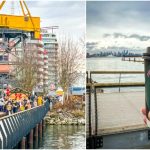Vancouver History: St Paul’s Hospital
The first time I heard of St Paul’s Hospital was when I was talking to my friend (and neighbour) about where we were born. We were about 9 or 10 years old and she told me she was born at St. Paul’s in Vancouver, which seemed strange to me since my brother, sister and I were all born at Surrey Memorial. I didn’t know that I would grow up and soon live within blocks of the historic building or that its future serving our major metropolitan area would be in jeopardy.
St Paul’s Hospital timeline (source, if not otherwise stated, is VancouverHistory.ca)
- 1892 – The Sisters of Providence arrived from Portland upon recommendation by Bishop Paul Durieu as Vancouver’s population was growing and in need of health care. They bought seven lots on the outskirts of Vancouver for $9,000 and a 25-bed hospital was completed in 1894. [source: Providence Health Care]
- November 22, 1894 – Bishop Paul Durieu blessed it the building (side note: the hospital is not named after St. Paul, but actually for Bishop Paul Durieu himself. [source: VancouverHistory]
- 1904 – 50 more beds added.
- September 1, 1907 – Official opening of a School of Nursing at St. Paul’s Hospital.
- 1912 – Construction began to expand St. Paul’s into a 120-bed hospital.
- 1921 – The staff at St. Paul’s Hospital devised a machine that controlled ether administration in the operating room.
- September 1, 1922 – Margaret Yvonne Middleton (Yvonne De Carlo) was born at St. Paul’s.
- 1959 – Dr Harold Rice at St Paul’s Hospital built Canada’s first heart-lung machine.
- 1960 – St. Paul’s Hospital opened BC’s first biomedical engineering department.
- 1966 – St Paul’s Hospital opened its intensive-care unit.
- 1983 – AIDS Vancouver was founded, the same year that St. Paul’s admitted its first AIDS patient.
- 1983 – Tower completed.
- 1991 – Additional 10-story tower completed.
In recent years, and with a growing population yet again, the hospital is running out of room. The PHC (Providence Health Care) and they are proposing an upgrade called the “Legacy Project”. As such, a group emerged a few years ago leading an initiative to Save St. Paul’s.
The Legacy Project includes two options. The first is construction and redevelopment on the current site that will take an estimated 15 years. The second (and I assume the less popular) is to build a new facility in South East False Creek on 18.5 acres, which would take 5-7 years.
Tomorrow while I’m on location with CBC’s Coast to Coast they will be speaking with members of the Save St. Paul’s Coalition as it is definitely a hot topic (as it was when I was doing my provincial candidate interviews last fall).
What are your thoughts? Should Vancouver expand and preserve it’s only downtown hospital or would it be better off in another location with more room to breathe?
[poll id=”25″]













8 Comments — Comments Are Closed
I’ve not used St.Pauls for anything really serious other than my daughter’s birth. Many have told me that the old heritage wing is in terrible need of replacement and support the building of a new hospital out on Terminal. All I know for sure is that the Providence Wing, where the maternity ward is, is fantastic! We even met another new mother there who had come all the way from Ladner (how many hospitals did they drive past?) who preferred St.Pauls to anywhere else. With our second child coming in July we are again planning to deliver in St.Pauls… bypassing two other hospitals on the way.
If it goes? Well, then my children share a special bond with me as having been born in hospitals which no longer exist.
I’ve always been amazed that the debate has become an either / or scenario – keep St. Paul’s OR build a new hospital…
Why not both?
The population downtown is exploding – 80,000 proposed to be 120,000 by 2020 (I think)
St. Paul’s is in bad shape and needs redevelopment – fact.
I see the solution as the construction of a new hospital in SE False Creek with the major trauma centres required in the region, high tech surgery centres, and upon completion, the redevelopment of St. Paul’s to a more local serving hospital with the required facilities. Renovate, redevelop, BUT keep the hospital but specialize it to treat those downtown.
While this will take a great deal of time and money, I think it’s in effect the ONLY solution to the issue of proper healthcare in Vancouver!
Being that the West End of Vancouver is the second most densely populated area in North America (second only to Manhattan), the need for this facility goes without saying. Downtown Vancouver simply cannot function without a full-service hospital. To move it to the outskirts of downtown would be a tragedy.
There is a huge debate about this inside the industry too. My gf did her practicum at St.Paul’s too.
I too think they should leave St.Pauls and renovate it while building a new hospital. Wanting to move the hospital to the other side of Vancouver would make it really hard for people in the west end to get to. VGH (now referred to as Vancouver Hospital) and Lions Gate are still not anywhere close for the west end residents to get to. Then again do they have enough staff in Vancouver Coastal Health to support another hospital?
[…] keys… 88 on the dial). The topics today will focus on the West End; from rent-o-victions to St. Paul’s and I’ll be adding my own notes, history tidbits and insights on living in this great […]
You missed the date in 1976 when I was born there 🙂
With a population that big in the downtown peninsula, and living in an earthquake zone, I don’t think you would want to have that many people that would have to cross a bridge to get help in the event of a disaster. Going around False Creek could be the difference between life and death.
[…] people to check out the Save St. Paul’s website for more information. Side note: according to a poll I conducted in January 2009, 72% of my readers would like to see the hospital remain […]
Can’t we not keep St. Paul’s in the old site and restructure it to meet some of our needs, and build a new one on Main and Terminal with improved and modern technologies and services? Our medical needs will be growing as our population grows, which is inevitable. We do not want to go through this problem in the future. Txs.